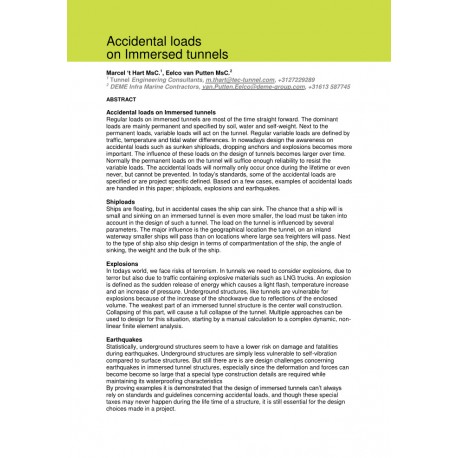Cart
0
0
No document
0,00 €
Total
Document successfully added to your shopping cart
Quantity
Total
There are 0 items in your cart.
There is 1 item in your cart.
Total documents
Total shipping
To be determined
Total
Search & filter
Search for a publication
Search & filter
Viewed documents

Accidental loads on Immersed tunnels
3642_accidental_loads_on_immerse
Accidental loads on Immersed tunnels : Regular loads on immersed tunnels are most of the time straight forward. The dominant loads are mainly permanent and specified by soil, water and self-weight. Next to the permanent loads, variable loads will act on the tunnel. Regular variable loads are defined by traffic, temperature and tidal water differences. In nowadays design the awareness on accidental loads such as sunken shiploads, dropping anchors and explosions becomes more important. The influence of these loads on the design of tunnels becomes larger over time. Normally the permanent loads on the tunnel will suffice enough reliability to resist the variable loads. The accidental loads will normally only occur once during the lifetime or even
never, but cannot be prevented. In today’s standards, some of the accidental loads are specified or are project specific defined. Based on a few cases, examples of accidental loads
are handled in this paper; shiploads, explosions and earthquakes. Shiploads : Ships are floating, but in accidental cases the ship can sink. The chance that a ship will is small and sinking on an immersed tunnel is even more smaller, the load must be taken into account in the design of such a tunnel. The load on the tunnel is influenced by several parameters. The major influence is the geographical location the tunnel, on an inland waterway smaller ships will pass than on locations where large sea freighters will pass. Next to the type of ship also ship design in terms of compartmentation of the ship, the angle of sinking, the weight and the bulk of the ship. Explosions : In todays world, we face risks of terrorism. In tunnels we need to consider explosions, due to terror but also due to traffic containing explosive materials such as LNG trucks. An explosion is defined as the sudden release of energy which causes a light flash, temperature increase
and an increase of pressure. Underground structures, like tunnels are vulnerable for explosions because of the increase of the shockwave due to reflections of the enclosed volume. The weakest part of an immersed tunnel structure is the center wall construction. Collapsing of this part, will cause a full collapse of the tunnel. Multiple approaches can be used to design for this situation, starting by a manual calculation to a complex dynamic, non-linear finite element analysis. Earthquakes :Statistically, underground structures seem to have a lower risk on damage and fatalities during earthquakes. Underground structures are simply less vulnerable to self-vibration compared to surface structures. But still there are is are design challenges concerning
earthquakes in immersed tunnel structures, especially since the deformation and forces can become become so large that a special type construction details are required while
maintaining its waterproofing characteristics. By proving examples it is demonstrated that the design of immersed tunnels can’t always rely on standards and guidelines concerning accidental loads, and though these special taxes may never happen during the life time of a structure, it is still essential for the design choices made in a project.


